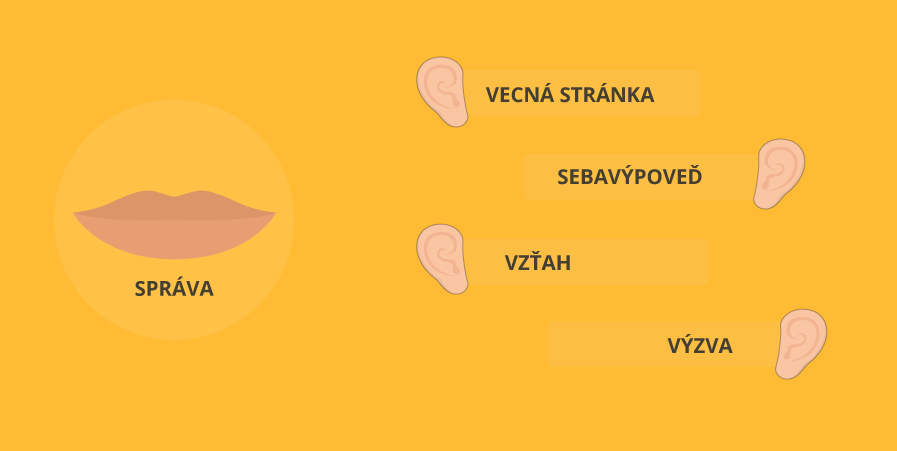Does it seem a bit anatomically inaccurate to you?
Perhaps.
However, below you will read that we actually have more of those psychological ears than a glance in the mirror reveals. We will discuss which ones they are, how to use them properly to make our communication and relationships as satisfying as possible, and you will also learn how much can be said in three words while waiting for the green light.
How do we communicate?
A group of psychologists led by Paul Watzlawick claim that all behavior is communication, and therefore, it is impossible not to communicate. Everything we say or do carries a certain meaning, message, attitude, or opinion that we communicate to another person. Even when we “do nothing”. Even when we are silent. Even when we turn in a different direction, or when we leave. In some cases, even more so.
That is why it is very important to learn how to understand how we actually communicate.
So what does this look like in practice? It’s not revealing anything new to say that there’s always a message sender who wants to communicate something, a message recipient, and finally the message itself. This message is first encrypted by the sender into a certain form, then it is sent (verbally, gesturally, visually), and on the recipient’s side, it is decoded.
What lies behind the words we speak (and not only in them)?
German psychologist Friedemann Schulz von Thun contributed to a better understanding of communication by specifically naming the four components, or semantic aspects, that every message contains, whether we are aware of it or not. What are they?
- Factual aspect – What facts does the message describe?
- Self-revelatory aspect – What does the message reveal about the sender?
- Relationship aspect – What does the message say about our relationship with each other?
- Appeal aspect – What does the sender want to achieve, what is their goal or appeal?

Sure! Here’s the translation of the example:
Imagine that you are sitting in a car behind the wheel and your friend or girlfriend is sitting in the passenger seat. You are at a crossroads, and the traffic light is red. At one point, the red light changes to orange and then to green. Your friend or girlfriend says the following sentence: “Ah, it’s green!”
What does this sentence actually tell us? Let’s take a closer look at it.
1.On a factual level, the message states that the traffic light is green.
2.On a self-disclosure level, it tells us that the sender is probably impatient and in a hurry.
3.In terms of our relationship, it suggests that I may need someone to remind me that it is green, that I need help because I don’t see it myself.
4.The call to action for this message could be “Let’s go!” or “Hurry up!”

We can apply the same approach to nonverbal communication as well. For example, if someone starts crying, the factual aspect of the communication might be missing, but the other three aspects are still present. The self-expression could be “I’m sad,” the relationship message could be “Your behavior has brought me to tears,” and the appeal could be “Comfort me, pay attention to me.”
Of course, we usually don’t perceive all of these meanings simultaneously. We filter out one based on the situation (or various other factors such as tone and melody of voice, accompanying glances, gestures, wider context of events, nature of our relationship, etc.) and react accordingly. We always receive the message with the “ear” that is currently tuned to one of these four aspects.
Try it out. What meanings can you decipher on each level if you heard someone say the following words?
And which one came to your mind first?
“Take your coat. It’s cold outside.”
“What’s for dinner?”
“This place is a mess!”
(There are multiple possible “solutions” and interpretations. Feel free to share your own in the comments.)
Listen with four ears!
In most cases, it’s clear to us what the message we receive means and therefore “what the other person meant to say.” That’s why we can usually agree with each other and understand each other to a greater or lesser extent.
However, the situation can become very complicated if the recipient assigns a different meaning to the message than what the sender originally intended.
We see that every message can be viewed from the four perspectives mentioned above (or at least three if the verbal statement is missing). Each of us is sensitive to them to varying degrees. As a passenger from the example above, I might have one of them in mind when I “send” the message, but I have no impact on how the driver will understand it (“decode” it). I only find out from their reaction. If I’m lucky.
Based on their own mood, experiences, imagination, or current emotional state – usually automatically, unconsciously – the recipient chooses which side to look at the message from, how to understand it, and what to actually react to. In other words, they choose which ears to listen to it with.
Do a little exercise and answer these questions:
Which level would I hear first in the role of the driver from the example?
Facts, friend’s self-disclosure, information about our relationship, or a call to action?
How would I react?
How would my reaction differ if I decided to “listen” to one of the other levels?
Misunderstandings often arise when we react to something other than what the other person intended to communicate. For example, if we argue about exactly how many dishes are in the sink and how long they’ve been there, but our partner actually wants to express that they need more help. Or if the other person just wants to state that they are hungry and we believe that they are demanding that we go cook for them immediately.
As recipients, we are responsible for how we handle the message and how we understand it!
Therefore, let’s pay more attention to which ears we are currently listening with. To avoid misunderstandings and communicate as effectively as possible, it is good to notice which ear we listen with more in which situations and how it then influences our reactions. Let’s listen with all four ears.
So what can I do to understand others as best as possible?
1.Don’t rush to interpret – verify what the other person meant before reacting automatically. Realize and take responsibility – for how I understand the other person and how I react to them.
2.Meta-communicate – talk about what we are talking about – especially if it is heading towards conflict or misunderstanding, take a step back and look at our conversation and what is happening in it, clarify it.
3.Talk more about myself and less about the other person (“You made me angry!” vs “I am angry!”).
4.Bring as much awareness and attention as possible into everyday communication – notice how I feel in the conversation, which ear I tend to use more, why I react the way I do?
5.Bring as much awareness and attention as possible into everyday communication – notice how I feel in the conversation, which ear I tend to use more, why I react the way I do? And finally, be forgiving to yourself and others in communication 🙂 It is so complex, has so many colors, layers, and levels, and so many other influences come into it that it would actually be more natural for misunderstandings to occur much more often. Every time we agree with ease, it’s almost a miracle. And yet we take it for granted every day.
Good luck!
